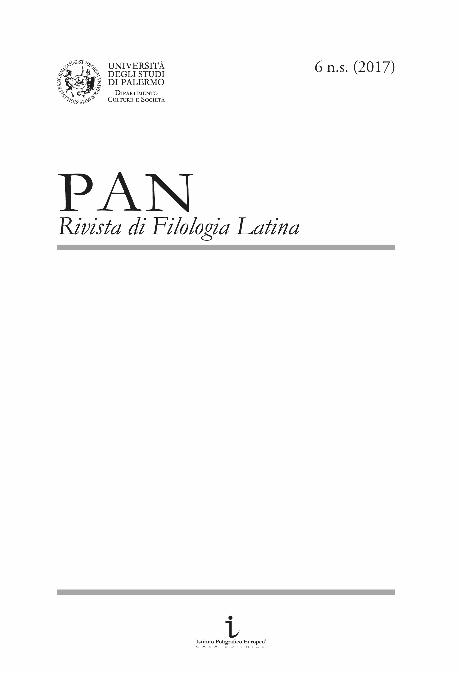Mostrar el registro sencillo del ítem
dc.contributor.author
Tola, Eleonora

dc.date.available
2019-04-24T21:07:00Z
dc.date.issued
2017-11
dc.identifier.citation
Tola, Eleonora; Gaze, Monstrosity, and the Poetics of History in Lucan; Università degli Studi di Palermo. Dipartamento Culture e Societá; Pan; 6; 11-2017; 115-123
dc.identifier.issn
0390-3141
dc.identifier.uri
http://hdl.handle.net/11336/74978
dc.description.abstract
The battlefield scene in Book 7 of lucan´s Bellum Ciuile clearly shows a redefinition of the traditional topos of the day after the battle. Although bloody scenes appeared in Latin literature since Early roman tragedy, Lucan´s Neronian epic provided a new interpretation of that literary convention by focusing on its gruesome aspects. The underlining of hideous details is a powerful expression of civil struggle´s anomaly and excess. On the one hand, internal strife relates to a subversion of usual warfare rules by facing roman to roman in the battleground; on the other hand, it also shows the excess of war, as the poet claims at the very beginning of his text. Within such a reading horizon, the uncommon performance of both parties connects Lucan´s narrative with the roman idea of monstrosity. The description of bloody scenes in Book 7 is even more complex because they involve Caesar himself. Moreover, as a cruel spectator of that landscape, Caesar strengthens the problematic status of the winning side in a brotherly killing, and the ambivalence of power in Lucan´s world. show that the intersection of historiographic, epic and tragic codes and the manipulation of some literary and cultural motifs function as a pivotal feature of Lucan´s poetics of roman history.
dc.description.abstract
Nel libro 7 del Bellum Ciuile lucano riscrive il topos tradizionale del giorno dopo la battaglia. sebbene la rappresentazione di scene di sangue fosse una convenzione letteraria riscontrabile nella letteratura latina sin dal teatro arcaico, l’epica lucanea ne fornisce un nuovo orientamento. il macabro diventa in lucano uno schema descrittivo essenziale per la narrazione dell’anomalia e degli eccessi della guerra civile, risultanti entrambi dalla contrapposizione di cittadini romani sul campo di battaglia. in quest’orizzonte di senso, la condotta inattesa ed insolita dei due eserciti collega la narrativa lucanea con l’idea romana di mostruosità. la descrizione del massacro dopo lo scontro decisivo di farsàlo è particolarmente ricca di significato perché coinvolge lo stesso cesare. crudele spettatore di quel paesaggio, cesare accentua lo status problematico dei vincitori in una lotta intestina e l’equivoco del potere nell’intero poema. Mostreremo che l’intersezione fra epica, storiografia e tragedia e la manipolazione di alcuni topoi letterari e culturali in quell’episodio costituiscono un aspetto centrale della poetica lucanea della storia di Roma.
dc.format
application/pdf
dc.language.iso
eng
dc.publisher
Università degli Studi di Palermo. Dipartamento Culture e Societá
dc.rights
info:eu-repo/semantics/openAccess
dc.rights.uri
https://creativecommons.org/licenses/by-nc-sa/2.5/ar/
dc.subject
Lucan
dc.subject
Battlefield
dc.subject
Poetics
dc.subject
History
dc.subject.classification
Estudios Generales del Lenguaje

dc.subject.classification
Lengua y Literatura

dc.subject.classification
HUMANIDADES

dc.title
Gaze, Monstrosity, and the Poetics of History in Lucan
dc.type
info:eu-repo/semantics/article
dc.type
info:ar-repo/semantics/artículo
dc.type
info:eu-repo/semantics/publishedVersion
dc.date.updated
2019-04-16T13:11:46Z
dc.journal.volume
6
dc.journal.pagination
115-123
dc.journal.pais
Italia

dc.journal.ciudad
Palermo
dc.description.fil
Fil: Tola, Eleonora. Consejo Nacional de Investigaciones Científicas y Técnicas; Argentina. Universidad de Buenos Aires; Argentina
dc.journal.title
Pan
dc.relation.alternativeid
info:eu-repo/semantics/altIdentifier/url/https://www.unipa.it/dipartimenti/cultureesocieta/riviste/pan/pan.-rivista-di-filologia-latina-6-n.s.-2017/
dc.relation.alternativeid
info:eu-repo/semantics/altIdentifier/doi/http://dx.doi.org/10.17417/0609
Archivos asociados
